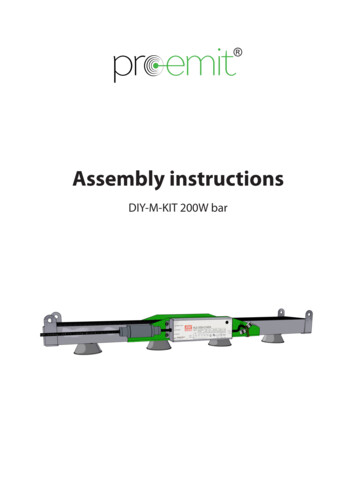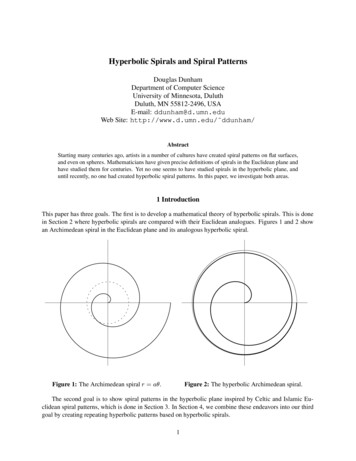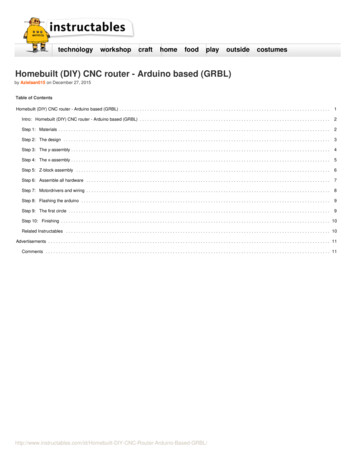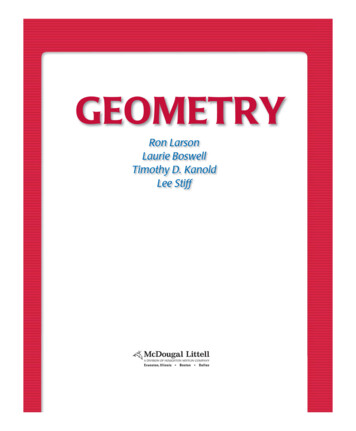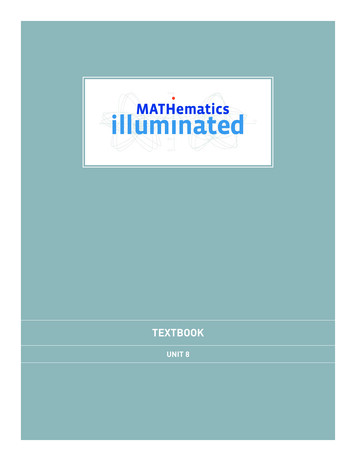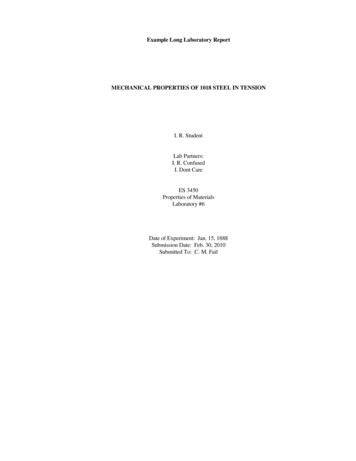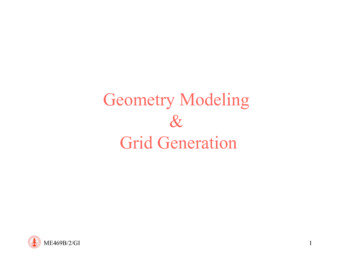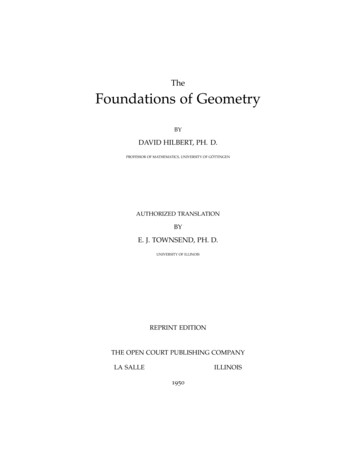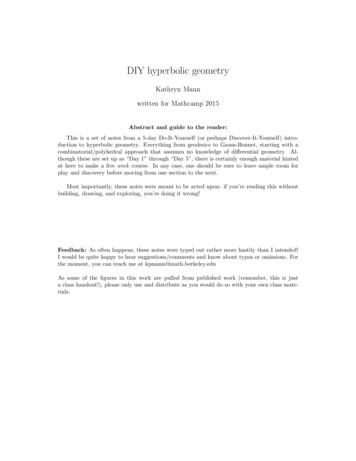
Transcription
DIY hyperbolic geometryKathryn Mannwritten for Mathcamp 2015Abstract and guide to the reader:This is a set of notes from a 5-day Do-It-Yourself (or perhaps Discover-It-Yourself) introduction to hyperbolic geometry. Everything from geodesics to Gauss-Bonnet, starting with acombinatorial/polyhedral approach that assumes no knowledge of differential geometry. Although these are set up as “Day 1” through “Day 5”, there is certainly enough material hintedat here to make a five week course. In any case, one should be sure to leave ample room forplay and discovery before moving from one section to the next.Most importantly, these notes were meant to be acted upon: if you’re reading this withoutbuilding, drawing, and exploring, you’re doing it wrong!Feedback: As often happens, these notes were typed out rather more hastily than I intended!I would be quite happy to hear suggestions/comments and know about typos or omissions. Forthe moment, you can reach me at kpmann@math.berkeley.eduAs some of the figures in this work are pulled from published work (remember, this is justa class handout!), please only use and distribute as you would do so with your own class materials.
Day 1: Wrinkly paperIf we glue equilateral triangles together, 6 around a vertex, and keep going forever, we build aflat (Euclidean) plane. This space is called E2 .Gluing 5 around a vertex eventually closes up and gives an icosahedron, which I would likeyou to think of as a polyhedral approximation of a round sphere.Gluing seven triangles around a single vertex gives a shape that is also curved, but not like asphere.Much like the 6-around a vertex Euclidean plane, we can continue to glue 7 triangles aroundeach vertex forever, building an infinite space. This space is the hyperbolic plane, also calledH2 . (Technically what we actually build with triangles is a polyhedral approximation of H2 –the real H2 is a smoothed-out version, like the sphere is in comparison with the icosahedron).Here’s a picture of a piece of it:2
Our goal for this week is to explore this space, first using paper models like these, thenthrough the more standard Poincaré disc and half-space models.GeodesicsA geodesic is often defined to be the shortest distance between two points. A better definitionof geodesic is a straight line, although it takes some time to make sense of what straight shouldbe in a curved space.On a folded piece of paper, geodesics are folded straight lines. The same applies to the icosahedron, and to our hyperbolic space models – to draw a geodesic starting in a given direction,draw a straight line on a triangle, and when you get to the edge, flatten the edge momentarilyand continue the straight line on the other side.Exercise 1 (Optional). Show that the geodesics on a sphere are exactly the great circles bylooking at straight lines on better and better polyhedral approximations of the sphere. (Theapproximations in the figure below are given by successively subdividing each triangular faceinto 4 equilateral triangles.)Exercise 2 (Geodesics on H2 ). Draw some geodesics on your paper model of H2 . What dothey look like? More specifically:1. Draw two geodesics which start out as parallel lines, but eventually diverge2. Draw a geodesic that contains a segment parallel to, and very close to, the edge of oneof the equilateral triangle pieces. Notice how it follows a path made up of edges. We’llcall these special geodesics edge-path geodesics. Try to describe all possible edge-pathgeodesics. What paths of edges can they follow?3. Draw a BIG triangle on H2 with all sides geodesics.4. Can you draw a (big) geodesic sided rectangle? (i.e. four sides, 90 degree corners). Drawingit inside a single flat triangle piece is cheating! If you can’t, can you prove that it’simpossible to do so? Hint/further question: What is the angle sum of your big geodesictriangle?We’ll return to study more properties of geodesic triangles later on. If you’re interested moregenerally in figuring out the right way to think about straight lines on curved spaces, I highlyrecommend the first chapters of Henderson’s book Experiencing Geometry [2].Area and circumference of discsConsider the Euclidean plane E2 tiled by unit side length triangles. We can estimate the areaof a disc of radius r by counting the number of triangles in it. Since the area of a triangle is aconstant (say λ) and a hexagon-worth of triangles fills out a fixed proportion of the disc (say κ),our count of the number of triangles gives λκ times the area of the disc. If we’re just interestedin understanding what area looks like as a function of r (is it linear? quadratic? polynomial?),we don’t even need to worry about what κ and λ are.We can similarly estimate the circumference of the disc using the circumference of the hexagon.We’ll call this the combinatorial area and length.3
Figure 1: An edge-path geodesic triangle (pretty much). Drawing by D. StudenmundFigure 2: a “radius r hexagon” fills out a fixed proportion of a disc of radius r.Definition 3. The combinatorial area of a region in a triangulated space is the number oftriangles in that region. The combinatorial length of a curve is the number of edges of trianglesthat make up that curve.In H2 , things are a little different than in E2 . Adding a 1-triangle thick annulus around ourstarting heptagon gives something that doesn’t quite look like a bigger heptagon (let’s call ita triangulated disc of radius 2) and our “fixed proportion of the area” argument doesn’t workhere. (Exercise: why not?). Still, counting the number of triangles in such a triangle-disc stillgives a reasonable first estimate of the area of a disc of radius 2. Adding more annular rings tobuild a bigger triangle-disc gives a reasonable approximation of discs of larger radii. See exercise5 below.Exercise 4. (Area and circumference in E2 and H2 )1. Find a formula for the combinatorial area and circumference of a hexagonal “disc” ofradius r in E2 .4
2. Find an estimate for the combinatorial circumference of a triangulated disc of radius r inH2 . (estimate some reasonable upper and lower bounds. Hint: try to bound below bysomething like 2r ).3. Find a formula or estimate for the combinatorial area of a triangulated disc of radius rin H2 . It may help to draw a flat picture of a space with 7 triangles around a vertex (aregular degree 7 graph) like in Figure 1 or use the one on the last page of these notes.Exercise 5. (optional) Assume our equilateral triangles have side length 1. Which pointson the circumference of the triangulated disc of radius r in H2 are distance (very close to) rfrom the center along edge-path geodesics? Why does this make our triangulated disc a goodapproximation of the genuine disc of radius r in H2 ?NotesThe polyhedral paper model of hyperbolic space was popularized by (and perhaps even inventedby?) W. Thurston. Although too advanced for our purposes here, he has a wonderful bookThree-Dimensional Geometry and Topology [4] that begins with a DIY-style introduction to H2 .Day 2: Mapping the hyperbolic planeThree projections of the sphereQuestion 6. Why are all maps of the earth imperfect in some way (distorting area, or angles,or distances)? In other words, why are all images of a sphere, or a part of a sphere, on a flatplane distorted?Many people answer this question with something like “because geodesics are curved (greatcircles) on the sphere, and straight lines on the plane. Curved things can’t be made straight”However, there is a way to represent the round earth – actually, half of it – on a flat plane,where the image of each geodesic is a straight line.1. Gnomonic projection (preserves straight lines)Gnomonic projection, from on.htmlThe gnomonic projection maps the lower hemisphere onto E2 (covering the whole plane).Theorem 7. The image of a great circle under the gnomonic projection is a straight lineProof. Each flat plane passing through the center of the sphere intersects the sphere along agreat circle. Conversely, each great circle can be described as the intersection of a plane throughC with the sphere. The rays defining the gnomonic projection stay on this plane, which thenintersects E2 in a straight line.5
Although geodesics under gnomonic projection are straight lines, the image of the sphere isquite badly distorted – notice how area is badly distorted at points far away from the point oftangency to the plane. If we want to preserve area, we can use cylindrical projection instead.2. Cylindrical projection (preserves area)Cylindrical projection, wikimedia commonsTheorem 8 (Archimedes). The area of any region on the sphere does not change under cylindrical projection.However, distances and angles can be very badly distorted – look what happened to Greenland in the picture. Moreover, though some great circles are mapped to straight lines undercylindrical projection (exercise – which ones?), not all are.3. Stereographic projection (preserves angles). Stereographic projection, shown below,preserves angles and sends small circles to circles. In fact, almost all circles are sent to circles.Exercise 9. Describe the image of great circles under stereographic projection.Exercise 10 (optional, challenging). Prove that cylindrical projection preserves area, and provethat stereographic projection preserves angles and sends circles to circles.Two projections of H21. The Poincaré disc. If you looked at the last page of the notes in order to do one of thecounting exercises in the last section, you have already seen a picture of the Poincaré disc model6
Figure 3: From D. Henderson’s Experiencing Geometry [2]of hyperbolic space – it’s that picture of “seven triangles around a vertex” – an infinite, regular,degree 7 graph, drawn so as to fit inside a round disc. But in order to fit inside the disc, thearea of triangles has to be more and more distorted. (Can you estimate how distorted, usingyour estimate on area from Exercise 4?)Exercise 11. (Geodesics in the disc)1. Draw the image of some geodesic segments on the Poincaré disc by copying them off ofyour paper model.2. Can you characterize what all edge-path geodesics look like?3. What does this tell you about straight lines in the Poincaré disc model? Does this remindyou of any of the projections of the sphere?The Poincaré disc also lets us talk about a smooth version of hyperbolic space. Think of thedisc as a uniform space, symmetric under any rotation about the center point (your paper modelhas 7-fold rotational symmetry at a vertex, and 3-fold about a point in the middle of a triangle).The disc is also symmetric under translations – just as in E2 , there is a translation taking anypoint to any other, and preserving distances and angles, in H2 there is also an isometry takingany point to any other.You can find some movies of isometries made by C. Goodman-Strauss here: http://comp.uark.edu/ strauss/hyperbolia/gallery2.html7
You can build a (almost) smooth paper model by gluing annuli together as in the instructions here. http://www.math.cornell.edu/ dwh/books/eg00/supplements/AHPmodel/.(This website also has instructions on how to crochet a model of H2 !)A paper model of the hyperbolic plane, constructed from annuli. es/To see that every point of H2 is like every other, cut out a small piece of the annuli modelsurface, and slide it around over the surface. Just as a small cap of a sphere of radius R can beslid smoothly to any point on the same sphere and then rotated by any angle, and a small pieceof flat plane can be slid and rotated around the plane, the same is true of H2 .The geodesics you drew on the Poincaré disc based on your triangulated hyperbolic spaceare not quite the same as geodesics on the smooth version, but are pretty close and give you ageneral idea of how they behave. On the smooth version, geodesics are semi-circles that meetthe boundary at right angles.2. The upper half space modelImagine taking a Poincaré disc of bigger and bigger radius. The boundary starts to lookmore and more straight as the disc grows. You can imagine this process “limiting” onto a halfplane. We think of the half-plane as an infinite-area disc with “circle” boundary a straight line.(There is a good way to make this idea precise using stereographic projection!) Here is a pictureof the 7-triangles around a vertex tiling on a piece of the half-plane.The benefit of this “map projection” of hyperbolic space is that it’s easy to describe thehyperbolic metric – in other words, what scale our map is at different places. If you draw a8
short line segment on the plane (say of length l) passing through a point with y-coorinate y0 ,it will represent a path of length approximately y0 l in H2 . In other words, distances at heighty are distorted by a factor of y.If you know about complex numbers and the complex plane, you can write down an easyformula for going between the disc and the upper half space models. Think of the disc as{z C : z 1} and the upper half plane as {z C : z a bi, and a 0}. Then thetransformationz if (z) z imaps the half-plane onto the disc. (And its inverse f 1 (z) iz iz 1 maps the disc to thehalf-plane).A function of the form f (z) az bcz d , where a, b, c and d are complex numbers, is called aMobius transformation. These have the property that the image of circles are circles. providedthat, as in stereographic projection, we consider a straight line as a kind of circle.Exercise 12. Using the fact that Möbius transformations map circles to circles and preserveangles, describe the geodesics of H2 in the upper-half plane model.Complex numbers can also be used to give a precise formula for distance. Any two points zand w in the upper half plane can be connected by a unique orthocircle – a vertical line or halfcircle meeting the x-axis at right angles. In fact, these orthocircles are the images of geodesicsin this model. To find the distance between z and w, first find the orthocircle through z and w,and name its endpoints A and B so that A, z, w, B reads in order along the path. (We let A orB be infinity if its a vertical line.) Thend(z, w) ln(w A)(z B)(A z)(B w)This fraction always turns out to be a real number greater than 1, so its logarithm is positive,and in fact d(z, w) gives a metric, a good notion of distance. (Of course, you need to checksymmetry – not hard – and the triangle inequality – rather tricky!).Exercise 13.1. Using this distance formula, check that a small line segment at height y haslength distorted by a factor of (approximately) y.2. Show that length is additive along vertical lines: if z1 , z2 and z3 are three points, in order,on the y-axis, then d(z1 , z2 ) d(z2 , z3 ) d(z1 , z3 ).3. To go further, read about the cross ratio in the book The Four Pillars of Geometry by J.Stillwell [3]. Then explain why hyperbolic distance is additive along orthocircles, not justvertical lines.3. The Klein model.Like the gnomonic projection of the earth, there is a projection of H2 onto the plane wheregeodesics are straight lines. It’s called the Klein (disc) model. Figure 4 is a picture comparingthe three different projections.That such a model exists is very special – the following theorem is a special case of a resultproved by Beltrami.Theorem 14. (Beltrami’s theorem) Suppose X is a space that has a projection to R2 wherethe image of each geodesic in X is a straight line. Then X is either a part of the plane, part ofa sphere, or part of H2 .9
Figure 4: Comparing projections of H2 .From www.geom.uiuc.edu/docs/forum/hype/model.htmlFigure 5: tiling of half space and disc by regular heptagonsVisualizing hyperbolic space in the different models through tilingsM.C. Escher drew dozens of tilings of Euclidean space, but only four tilings of the Poincaré disc.These hyperbolic tling were extremely labor intensive– without computers (or even a calculator),it is remarkably difficult to produce a precise regular tiling of the Poincaré disc. Escher hadsome mathematical help from geometer H.S.M. Coxeter, but had to do the drawing on his ownwith standard drafting tools (e.g. ruler and compass).Jos Leys, using computers, has recently transformed a number of Escher’s tilings of theplane into tilings of H2 . See http://www.josleys.com/show gallery.php?galid 325 formany beautiful examples on both the Poincaré disc and upper half plane. model.Exercise 15 (optional, challenge). Can you figure out what Leys’ method is (not the technicaldetails, just the general strategy) for turning a tiling of the Euclidean plane into a tiling of the10
Figure 6: tiling of half space and disc by regular lizards (Jos Leys, after M.C. Escher.)What symmetries of H2 are visible here?hyperbolic plane?We’ll look more at tilings and symmetries on Day 4.Day 3: Hyperbolic and spherical triangles, curvatureThe area of a triangle on a sphereA lune is a wedge of a sphere, cut out by two great circles. Since the total area of a sphere ofradius R is 4πR2 , the area of a lune of angle α is 4πR2 (α/2π) 2αR2 .One can calculate the area of a spherical triangle by examining how the three pairs of lunesdetermined by the pairs of adjacent sides of a triangle cover the sphere, with some overlap. It’sbest to do this by drawing on a physical sphere (orange, grapefruit, tennis ball.)Exercise 16. (Spherical triangles)1. What is a formula for a triangle with angles α, β, γ on a sphere of radius R?2. What angle sums are possible?11
The area of a triangle on H2We use a similar method to derive the formula for a triangle on H2 . This strategy is taken fromChapter 7 of [2].We’ll need to use one fact about the hyperbolic plane that we discussed yesterday: everypoint is exactly like every other. Precisely, given any two points, there is an isometry of H2 ,analogous to a translation of the plane, that takes one point to the other. And given any singlepoint, there is an isometry that rotates around that point. (This is easiest to see in the Poincarédisc when you rotate around the center of the disc).First we define a special region of hyperbolic space that will play the role of the lune.Definition 17. A one-angle triangle (OAT) of exterior angle α is the region in H2 cut out bytwo geodesic rays forming an angle of π α at a point, together with a third infinite geodesicconnecting their endpoints.On the left of Figure is a picture of such a region on the Poincaré disc:(a) An OAT of exterior angle α(b) as a limit of finite triangles.Although this seems to make perfect sense on our picture of the disc and on the upper halfplane, the “endpoints” of the rays are actually infinite distance away from the center. Trythinking about what this region looks like on your wrinkly paper! To make this definitionabsolutely precise, we should really talk about the OAT as a limit of finite regions as on theright of the figure above.The fact that there is an isometry of H2 taking any point and direction to any other meansthat every OAT of angle α is isometric to any other OAT of exterior angle α. In particular,they all have the same area. Let A(α) denote the area of an OAT of exterior angle αExercise 18. Show that A is additive, i.e. that A(α) A(β) A(α β).Since A is continuous (in fact, all you really need is that A is monotone – a smaller externalangle gives a smaller area), and additive, it must be linear. So there is some constant λ so thatA(α) λα.When α π, we get a “triangle” with all angles equal to 0. This is called an ideal triangle,and has all vertices on the boundary of the disc.Exercise 19. Derive a formula for a hyperbolic triangle with angles a, b, c in terms of λ. (a bighint is given in Figure 9 below.) Note that in particular, you just proved that the angles of atriangle determine the area!You’ll notice that you also showed that a hyperbolic triangle always has angle less than 180degrees, and that the maximum possible area is πλ, which occurs when the triangle is an idealtriangle.Exercise 20. Derive a formula for the area of a polygonal region with geodesic sides (on theunit sphere, and in H2 ) in terms of the angles at the vertices, by dividing the region up intotriangles.12
Figure 8: From [2], a hint for additivity of A(α)Figure 9: Hint for exercise 19The Gauss-Bonnet formulaJust as the formula for area of triangles (or polygons) on the sphere depended on the radius,the formula on H2 depended on λ. Like spheres, hyperbolic spaces come with different degreesof curvyness, and our constant λ is a measure of how “curved” the space is. The area formulawe derived is a special case of a famous theorem:Theorem 21 (Gauss-Bonnet for polygons). For any polygon P on a sphere, in E2 or on H2with geodesic sides, we havearea(P ) 1(2π sum of external angles)Kwhere K is the curvature of the space.13
The flat plane E2 has curvature 0, a sphere of radius R has curvature 1/R2 (bigger spheresare less curved), and the hyperbolic plane has negative curvature. The description of the metricon the Poincaré disc given above is for a space with curvature -1. It is possible to calculatethe approximate curvature of the model you made out of equilateral triangles (just like you cansay what the “radius” of an icosahedron is), and this depends on the size of the triangles thatyou are working with.Some spaces cannot be assigned a single number for curvature – they are more or less curvyin different places. Instead, one assigns a different number to each point in the space, calledthe Gaussian curvature at that point. The Gaussian curvature is negative if there is “too mucharea” in the immediate region around the point (such spaces are locally saddle-shaped), positiveif there is “too little area” (like on the sphere), and zero if the immediate area around the pointis isometric to a flat plane (flat, conical, or cylindrical).A surface with non-constant curvatureEven worse!Exercise: Which points on these spaces have positive (respectively, negative) curvature?The Gauss-Bonnet formula generalizes to these spaces too, but you need to measure theaverage curvature over a region by taking an integral.Further notesAll of high school trigonometry (cosine law, sine law, special properties for right triangles, etc.)can be done on the sphere and in hyperbolic space, the trigonometric identities just take aslightly different form. See Chapter 6 in [2] for an introduction to congruencies of triangles, and[4] for more hyperbolic trigonometry.Day 4: Tilings, isometries, and hyperbolic soccerToday we explore the many different ways to tile the hyperbolic plane. We’ll discuss a number ofdifferent strategies, with the goal of a) making some art like M.C. Escher, and b) understanding(groups of) symmetries of H2 .Hyperbolic soccerWe can build a “rounder” polygonal approximation of the sphere by slicing off each corner of theicosahedron. The result is a truncated icosahedron, the original triangle sides are now hexagonsand the sliced off vertices form new pentagonal sides. This shape is also known by the technicalterm soccer ball.14
Let’s do the same with our tiling of H2 . What do we get?Exercise 22. Build a hyperbolic soccer ball plane. You can find detailed instructions and atemplate here: http://theiff.org/images/IFF HypSoccerBall.pdfExercise 23. (Challenge: What is the shape of a hyperbolic soccer ball?) Is it possible to makea real ball with heptagons and hexagons in the hyperbolic soccer pattern? Is it possible to makeany closed shape? If so, what would it look like?Exercise 24. (Version of the exercise above, with more guidance) Use an Euler characteristicargument to show that you can’t make cover a ball with the hyperbolic soccer pattern. In fact,any closed surface tiled by heptagons and hexagons, with three faces meeting at every vertex,must have negative Euler characteristic (unless there are no heptagons, in which case you canhave Euler characteristic zero).Addendum to exercise: I had some fantastic students come up with a plan for a hyperbolicgenus 2 soccer surface. Can you do it?Dual polyhedra and dual tilingsAnother way to construct a new tiling is to take the dual of an existing one.Definition 25. The dual of a tiling is constructed by taking the center of each tile as a vertexand joining the centers of adjacent tiles. The dual of a polyhedron is constructed similarly, bytaking the center of each face to be a vertex. (In fact, it’s exactly the same construction if youconsider a polyhedron as a “tiling” of the sphere)from Exercise 26. Show that the dual of the dual of a polyhedron (or tiling) is the original polyhedron (tiling).15
Exercise 27. Prove that every symmetry of a polyhedron is also a symmetry of its dual polyhedron. Prove that every symmetry of a tiling of the plane is also a symmetry of its dual. Showthe same is also true for the hyperbolic plane. (this should help you understand isometries ofH2 )Exercise 28. (optional, assumes you know some group theory.) Describe the groups of symmetries of each of the Platonic solids. Which have the same symmetry group? Which are dualsof each other?Which shapes tile the hyperbolic plane?i) Triangles and regular tilings. Take a geodesic triangle with angles π/p, π/q and π/r forsome integers p, q, r. Reflect it in one of it’s sides, this gives another triangle with the sameangles, lined up with the first. If you keep going, you’ll eventually get 2p triangles around thevertex of angle π/p, (and 2q around the π/q vertex, and 2r around the π/r vertex). If you keepgoing forever, you eventually fill all of hyperbolic space.This is easiest to see if you start by running the same kind of experiment with a 90 45 45triangle in Euclidean space. The tiling of E2 that you get is pretty boring, but in hyperbolicspace there are many more options, because there exist triangles with any angle sum of 180degrees. Here’s an example of a π/2, π/3, π/7 triangle tiling.Exercise 29. What π/p, π/q, π/r triangles exist in E2 ? What tilings do they give? What aboutin H2 ? Can you visualize what these tilings look like?If you take two adjacent triangles and merge them into 1, this shape also tiles the plane, andthe tiles are not reflected but rotated and translated copies of each other. You can even takemore than two – below is an example of tilings created out of 14 triangles each (outlined in red,the other in blue) – one making up heptagons, and the other large triangles. Look familiar?Using a similar strategy, you can show that you can tile hyperbolic space with any regularpolygon, and in many different ways.Exercise 30 (Tiling with regular polygons). . Define a regular polygon to be a polygon withall sides equal length, and all angles equal.1. Show that you can tile the hyperbolic plane with regular 4-gons (squares), with 5 aroundeach vertex.2. Show that you can tile the hyperbolic plane with regular 4-gons, with n around each vertex,for any n 516
3. Show that you can tile the plane with regular n-gons. How many must you put aroundeach vertex (you have options). In each case, what must the interior angle of the n-gonbe?Exercise 31 (Symmetry groups, optional). If you know something about groups of symmetries,or in particular about reflection groups in E2 , you can try to generalize this to H2 . What canyou say about reflection groups in H2 ? Can you get new, different groups? Start by trying tounderstand the group created by reflections in the sides of the π/2, π/3, π/7 triangle. Stillwell’sbook [3] is a good introductory resource on this.ii) Semi-regular tilings Escher’s Circle limit 3 is a tiling based on squares and triangles. Youcan make a polygonal approximation of this by taking cutting out squares and triangles frompaper, and taping them together according to Escher’s pattern.To create another semi-regular tiling of hyperbolic space, pick a finite collection of regularpolygons, and find a way to glue them together so that there is more than 360 degrees of angleat each vertex. You also want there to be some pattern to the gluing – it should be invariantunder translations in two different directions, so that there is a network of points scatteredthroughout the space and a symmetry (“translation”) taking each point to each other. (Sucha network of points is called a lattice). The result is a polyhedral approximation of H2 , with asemi-regular tiling.For an easy example, you can modify Escher’s fish pattern to consist of pentagons andtriangles. Figure 11 shows a picture of the result, created by D. Dunham. For more examples,see [1].17
Figure 11: A semi-regular tiling of H2 decorated with fish. Image by D. Dunham [1]How to tesselate be M. C. EscherNow that we’ve tiled H2 with polygons, we can modify these to produce tilings by more interesting shapes (lizards, fish,.). The general recipe is as follows:1. Take a tiling by polygons, and think deeply about the symmetries of this tiling.2. Imagine translating one of the polygons to one of its copies, in a way that realizes asymmetry of the tiling. Which sides of the original polygon land on which sides of thecopy?18
3. Using this information, remove a piece of one side of your polygon and glue it onto another,puzzle-piece style. Voilà, a new tiling, by a more interesting shape. (warning: you mighthave to remove-glue from the same side!)Exercise 32. Explore! Create some original tilings of hyperbolic space!Day 5: PotpourriMost of today will be devoted to catching up and working on exercises from the previous days,but here are a couple extra tidbits, just for fun. The first is about tiling Euclidean space,the second a foray into the 3-dimensional world, and the third a discussion of sports in thehyperbolic plane.i) You can’t tile the plane with heptagonsWe start with a warm-up theorem:Theorem 33. You can’t tile the plane with regular heptagonsProof. Glue regular heptagons toge
draw a straight line on a triangle, and when you get to the edge, atten the edge momentarily and continue the straight line on the other side. Exercise 1 (Optional). Show that the geodesics on a sphere are exactly the great circles by looking at straight lines on better
